The Laysan Albatross (Phoebastria immutabilis) is a remarkable seabird known for its impressive wingspan, graceful flight, and fascinating life history.
Endemic to the Northwestern Hawaiian Islands, this species is renowned for its extensive oceanic journeys, often spanning thousands of miles in search of food.
With a wingspan reaching up to 7 feet, the Laysan Albatross is one of the biggest flying birds in the world. Its plumage is predominantly white, adorned with black markings on its wings and back, creating a distinctive appearance.
These birds exhibit remarkable fidelity, often returning to the same breeding sites year after year, forming large colonies on remote islands.
Despite their majestic presence in the skies, Laysan Albatrosses face threats from habitat degradation and accidental bycatch, highlighting the importance of conservation efforts to safeguard their populations and preserve their vital role in marine ecosystems.
Pick Out Criteria of Laysan Albatross
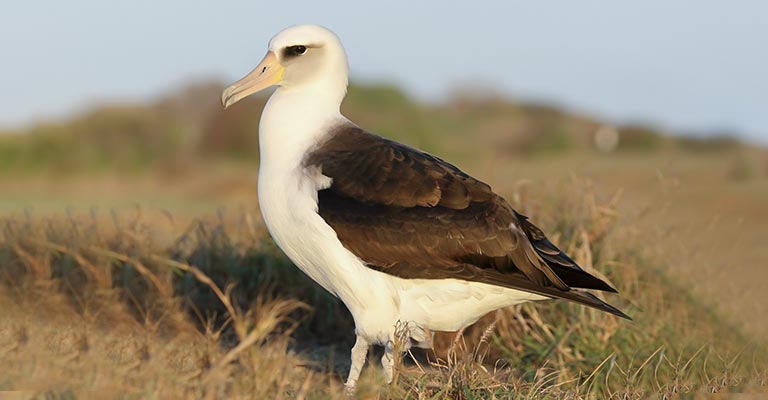
Identifying the Laysan Albatross (Phoebastria immutabilis) can be fascinating, as this seabird boasts distinctive characteristics that set it apart from other species.
Here are eight critical criteria to help identify this magnificent bird:
Wingspan
The Laysan Albatross possesses an impressive wingspan, reaching up to 7 feet (2.1 meters) in length. This wingspan is one of the largest bird species, allowing efficient gliding over vast oceanic distances.
Plumage
Its plumage is predominantly white, with varying shades of cream and ivory covering most of its body. The upper parts, including the wings and back, feature black markings, contrasting starkly with the white feathers.
Head and Neck
The head of the Laysan Albatross is relatively small in proportion to its body, with a short, stout bill. Its neck is slender and elongated, giving the bird a graceful appearance both in flight and while resting on land.
Eye Color
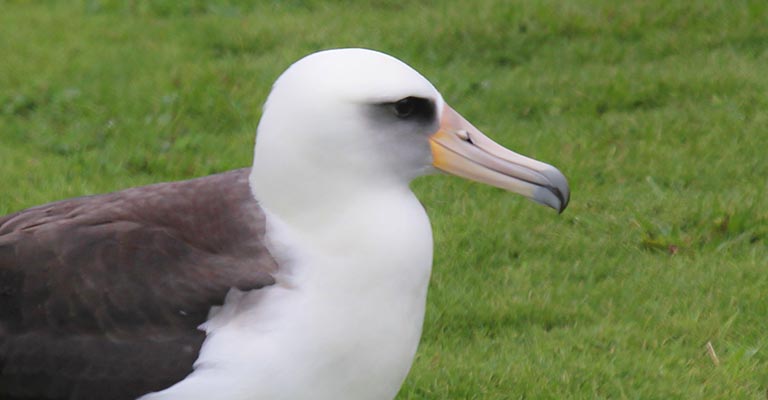
A distinguishing feature of the Laysan Albatross is its dark eye color, which contrasts with the surrounding white plumage. The eyes are relatively large and set prominently on the bird’s face.
Bill
The bill of the Laysan Albatross is pale yellow, with a hooked tip that aids in capturing prey such as fish and squid. The bill is strong and well-suited for grasping and manipulating food items at sea.
Legs and Feet
The legs of the Laysan Albatross are short and positioned towards the rear of the body, reflecting its primarily aerial lifestyle. The feet are webbed, adapted for swimming and walking on land, although the bird spends most of its time in flight.
Flight Pattern
When in flight, the Laysan Albatross exhibits a distinctive soaring pattern, characterized by graceful glides and occasional flapping of its wings.
Its wings are long and narrow, ideal for efficient long-distance flight over the open ocean.
Behavior
Observing the behavior of the Laysan Albatross can also aid in identification. These birds often soar effortlessly over the ocean surface, occasionally dipping to snatch prey from the water.
During the breeding season, they form large colonies on remote islands, engaging in elaborate courtship displays and nest-building activities.
By paying close attention to these criteria, birdwatchers and researchers can confidently identify the Laysan Albatross in its natural habitat, appreciating its unique features and remarkable sea life adaptations.
Taxonomy of Laysan Albatross
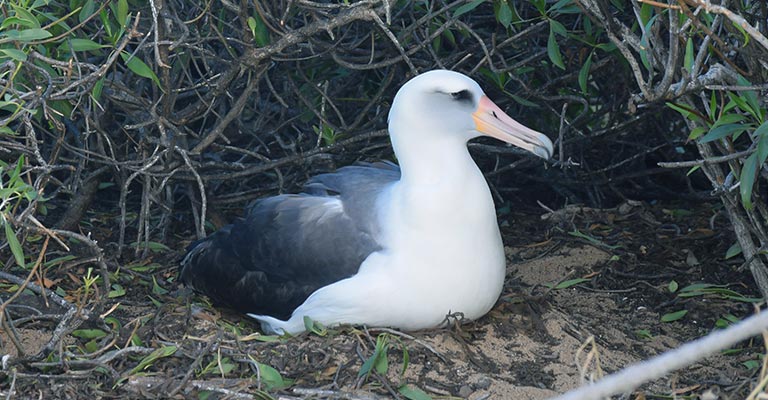
Here is the table detailing the taxonomy of Laysan Albatross:
| Taxonomic Rank | Classification |
| Domain | Eukaryota |
| Kingdom | Animalia |
| Phylum | Chordata |
| Class | Aves |
| Order | Phaethontiformes |
| Family | Diomedeidae |
| Genus | Phoebastria |
| Species | P. immutabilis |
The Laysan Albatross (Phoebastria immutabilis) belongs to the family Diomedeidae, which comprises large seabirds known for their remarkable flying abilities.
Within the family, it is classified under the genus Phoebastria, alongside other albatross species. The genus Phoebastria is part of the order Procellariiformes, commonly referred to as the tubenoses, which includes albatrosses, petrels, and shearwaters.
Procellariiformes are characterized by their tubular nostrils, adapted for efficiently expelling excess salt. The Laysan Albatross is explicitly distinguished by its large size, distinctive plumage, and extensive range across the North Pacific Ocean.
Reproduction of Laysan Albatross
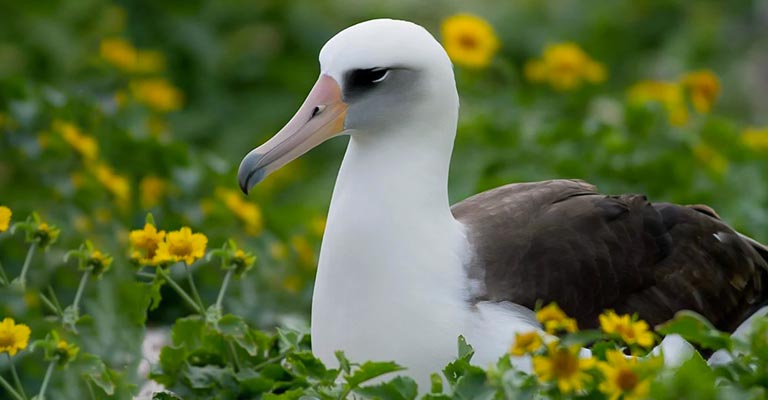
The reproduction process of the Laysan Albatross is a fascinating aspect of their life cycle. These seabirds typically breed in large colonies on remote islands, forming monogamous pairs that often mate for life.
Courtship rituals involve elaborate displays such as sky-pointing and bill clacking, strengthening the bond between mates.
Nesting occurs in flat, sandy areas where the female lays a single egg, usually in November or December. Both parents take turns incubating the egg, which lasts approximately two months.
Once hatched, the chick is cared for by both parents, who take turns foraging for food at sea and regurgitating it for the chick. The chick proliferates and reaches fledging age at around five to six months.
Laysan Albatrosses typically reach sexual maturity at around five to seven years of age, joining the breeding population and continuing the reproduction cycle.
Laysan Albatross Life History
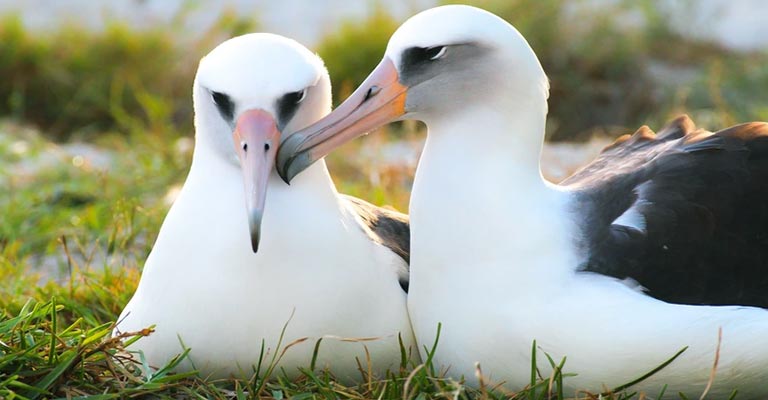
The Laysan Albatross (Phoebastria immutabilis) is a remarkable seabird with a fascinating history.
Endemic to the Northwestern Hawaiian Islands, these majestic birds are known for their extensive oceanic journeys and unique adaptations for life at sea.
Let’s explore various aspects of the Laysan Albatross’s life history, including food preferences, habitat requirements, breeding behavior, diseases, treatment, and conservation efforts.
Food
Laysan Albatrosses are opportunistic feeders, primarily preying on fish, squid, and crustaceans. They forage by plunge-diving or surface-seizing prey from the ocean’s surface.
These birds have a keen sense of smell, enabling them to locate food sources over vast distances. They often follow fishing vessels or congregate in areas of upwelling, where nutrient-rich waters attract prey species.
Habitat
The Laysan Albatross spends most of its life at sea, typically across the North Pacific Ocean. They are aquatic birds, preferring open ocean habitats but returning to land for breeding and nesting purposes.
Breeding colonies are established on remote, low-lying islands with sandy or grassy nesting sites, protecting them from predators and suitable conditions for raising chicks.
Range Map
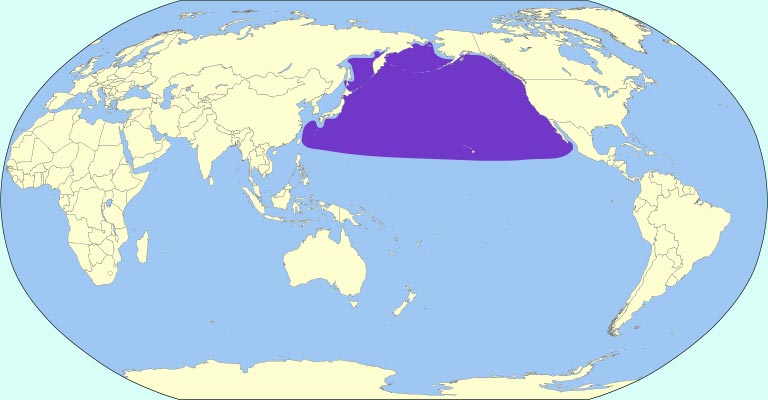
The range of the Laysan Albatross extends throughout the North Pacific Ocean, with breeding colonies primarily concentrated in the Northwestern Hawaiian Islands.
These include Midway Atoll, Laysan Island, and other atolls and islets within the Papahānaumokuākea Marine National Monument.
Breeding
Breeding occurs annually, with pairs returning to the same breeding sites year after year. Courtship rituals involve elaborate displays, strengthening the pair’s bond.
Females lay a single egg, and both parents take turns incubating it for approximately two months. After hatching, the chick is cared for by both parents, who provide food and protection until it fledges.
Diseases and Treatment
Laysan Albatross populations face threats from diseases such as avian botulism and lead poisoning, often resulting from ingesting marine debris.
Conservation efforts include monitoring for disease outbreaks, rehabilitation of affected individuals, and public awareness campaigns to reduce marine pollution.
Conservation
Conservation efforts are critical for safeguarding Laysan Albatross populations and their habitat.
Measures include establishing protected marine areas, habitat restoration on breeding islands, and initiatives to mitigate threats such as bycatch in fisheries and plastic pollution.
Public education and community involvement are integral to ensuring the long-term survival of these magnificent seabirds.
Nesting Habit of Laysan Albatross
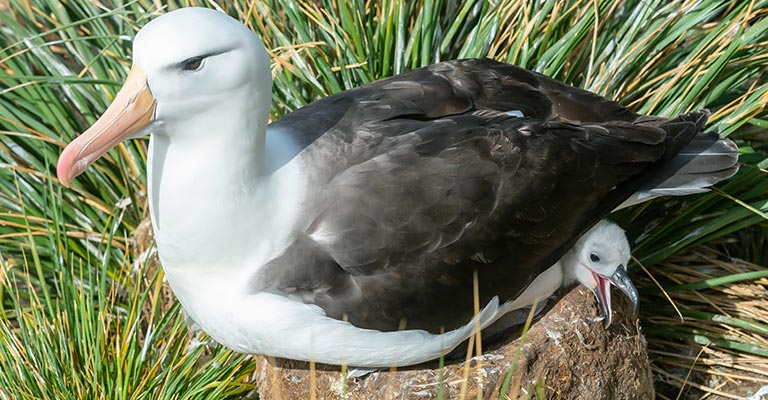
Laysan Albatrosses typically nest in large colonies on remote, low-lying islands, forming superficial scrapes or depressions in sandy or grassy substrates.
Each breeding pair usually lays a single egg, which is creamy-white with a calcareous shell and measures approximately 10-12 centimeters in length and 6-8 centimeters in width.
Both parents take turns incubating the egg for around 65-70 days, with the chick hatching after this period.
Parental care continues as they feed and protect the chick until it fledges at around 5-6 months of age, marking the beginning of its independent life at sea.
| Nesting Detail | Information |
| Clutch Size | Typically, one brood per breeding season |
| Number of Broods | Creamy-white with a calcareous shell, often speckled or stained with dirt or guano. |
| Egg Length | Approximately 10-12 centimeters (3.9-4.7 inches) |
| Egg Width | Approximately 6-8 centimeters (2.4-3.1 inches) |
| Incubation Period | Around 65-70 days |
| Nestling Period | Approximately 5-6 months until fledging |
| Egg Description | Simple scrape or depression in the sandy or grassy substrate |
| Nest Construction | Simple scrape or depression in sandy or grassy substrate |
This table provides a comprehensive overview of the nesting habits and characteristics of the Laysan Albatross, detailing factors such as clutch size, egg dimensions, incubation and nestling periods, egg description, nest construction, and parental care behaviors.
10 Behavioral Habits of Laysan Albatross
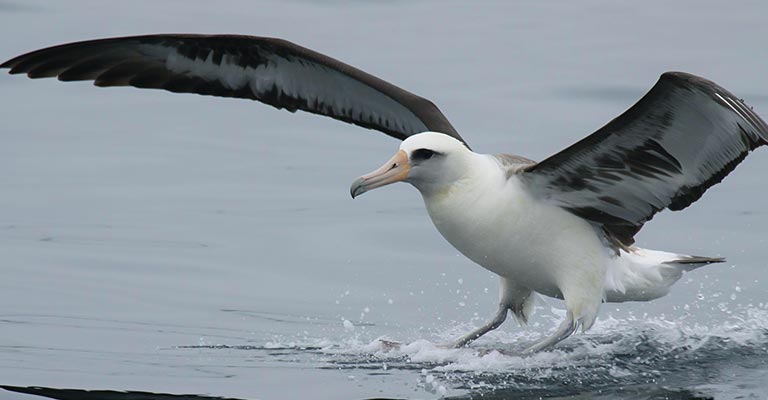
Laysan Albatrosses exhibit various fascinating behavioral habits contributing to their survival and success in their oceanic environment.
From intricate courtship displays to efficient foraging strategies, these seabirds showcase remarkable behaviors.
Here are ten notable behavioral habits of the Laysan Albatross:
- Courtship Rituals: During the breeding season, Laysan Albatrosses engage in elaborate courtship displays, including sky-pointing, bill clacking, and mutual preening, to strengthen pair bonds and select mates.
- Monogamous Pairing: Once paired, Laysan Albatrosses typically remain faithful to their mates, returning to the same breeding sites year after year to reunite and breed.
- Colonial Nesting: Laysan Albatrosses breed in large colonies, establishing nests near one another. This colonial nesting behavior protects predators and facilitates social interactions.
- Long-Distance Foraging: These seabirds are highly adapted for long-distance foraging flights over the open ocean, covering vast distances in search of prey such as fish, squid, and crustaceans.
- Efficient Gliding: Laysan Albatrosses use their long wings to soar effortlessly on air currents for extended periods, conserving energy during long-distance flights.
- Parental Care: Both parents take an active role in caring for their offspring, sharing responsibilities such as incubating the egg, feeding the chick, and providing protection from predators.
- Vocalizations: Laysan Albatrosses communicate with various vocalizations, including low-pitched groans, bill clacking, and whistling sounds, which are used for mate attraction, territory defense, and social interactions.
- Territorial Defense: Breeding pairs defend their nesting territories from intruders, engaging in aggressive displays and vocalizations to deter potential threats and maintain exclusive access to resources.
- Feeding Frenzies: Laysan Albatrosses often congregate in large groups at feeding sites, where they engage in feeding frenzies, diving, and surface-seizing prey in a coordinated fashion to maximize foraging efficiency.
- Mobility: Outside the breeding season, Laysan Albatrosses are highly mobile, undertaking extensive migrations and dispersing across vast oceanic expanses in search of food and suitable foraging grounds.
These behavioral habits exemplify the adaptability and resilience of Laysan Albatrosses in their oceanic environment, allowing them to thrive despite the challenges of life at sea.
Wrapping Up
The Laysan Albatross is a testament to the marvels of nature’s adaptation and resilience.
From its majestic wingspan to its intricate courtship rituals and efficient foraging strategies, this seabird embodies the beauty and complexity of life in the open ocean.
However, amidst its remarkable behaviors lies a vulnerability to human-induced threats such as habitat degradation, pollution, and climate change.
As stewards of our planet, we must take action to conserve and protect the habitats of the Laysan Albatross and other marine species.
By doing so, we not only safeguard the biodiversity of our oceans but also honor the legacy of these magnificent seabirds for generations to come.